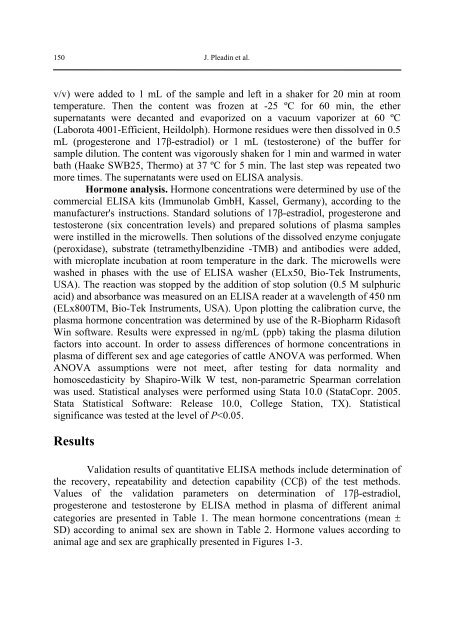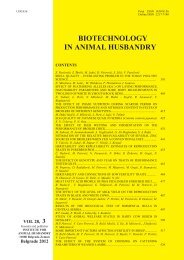Biotechnology in Animal Husbandry - Institut za Stočarstvo
Biotechnology in Animal Husbandry - Institut za Stočarstvo
Biotechnology in Animal Husbandry - Institut za Stočarstvo
Create successful ePaper yourself
Turn your PDF publications into a flip-book with our unique Google optimized e-Paper software.
150<br />
J. Plead<strong>in</strong> et al.<br />
v/v) were added to 1 mL of the sample and left <strong>in</strong> a shaker for 20 m<strong>in</strong> at room<br />
temperature. Then the content was frozen at -25 ºC for 60 m<strong>in</strong>, the ether<br />
supernatants were decanted and evaporized on a vacuum vaporizer at 60 ºC<br />
(Laborota 4001-Efficient, Heildolph). Hormone residues were then dissolved <strong>in</strong> 0.5<br />
mL (progesterone and 17β-estradiol) or 1 mL (testosterone) of the buffer for<br />
sample dilution. The content was vigorously shaken for 1 m<strong>in</strong> and warmed <strong>in</strong> water<br />
bath (Haake SWB25, Thermo) at 37 ºC for 5 m<strong>in</strong>. The last step was repeated two<br />
more times. The supernatants were used on ELISA analysis.<br />
Hormone analysis. Hormone concentrations were determ<strong>in</strong>ed by use of the<br />
commercial ELISA kits (Immunolab GmbH, Kassel, Germany), accord<strong>in</strong>g to the<br />
manufacturer's <strong>in</strong>structions. Standard solutions of 17β-estradiol, progesterone and<br />
testosterone (six concentration levels) and prepared solutions of plasma samples<br />
were <strong>in</strong>stilled <strong>in</strong> the microwells. Then solutions of the dissolved enzyme conjugate<br />
(peroxidase), substrate (tetramethylbenzid<strong>in</strong>e -TMB) and antibodies were added,<br />
with microplate <strong>in</strong>cubation at room temperature <strong>in</strong> the dark. The microwells were<br />
washed <strong>in</strong> phases with the use of ELISA washer (ELx50, Bio-Tek Instruments,<br />
USA). The reaction was stopped by the addition of stop solution (0.5 M sulphuric<br />
acid) and absorbance was measured on an ELISA reader at a wavelength of 450 nm<br />
(ELx800TM, Bio-Tek Instruments, USA). Upon plott<strong>in</strong>g the calibration curve, the<br />
plasma hormone concentration was determ<strong>in</strong>ed by use of the R-Biopharm Ridasoft<br />
W<strong>in</strong> software. Results were expressed <strong>in</strong> ng/mL (ppb) tak<strong>in</strong>g the plasma dilution<br />
factors <strong>in</strong>to account. In order to assess differences of hormone concentrations <strong>in</strong><br />
plasma of different sex and age categories of cattle ANOVA was performed. When<br />
ANOVA assumptions were not meet, after test<strong>in</strong>g for data normality and<br />
homoscedasticity by Shapiro-Wilk W test, non-parametric Spearman correlation<br />
was used. Statistical analyses were performed us<strong>in</strong>g Stata 10.0 (StataCopr. 2005.<br />
Stata Statistical Software: Release 10.0, College Station, TX). Statistical<br />
significance was tested at the level of P




